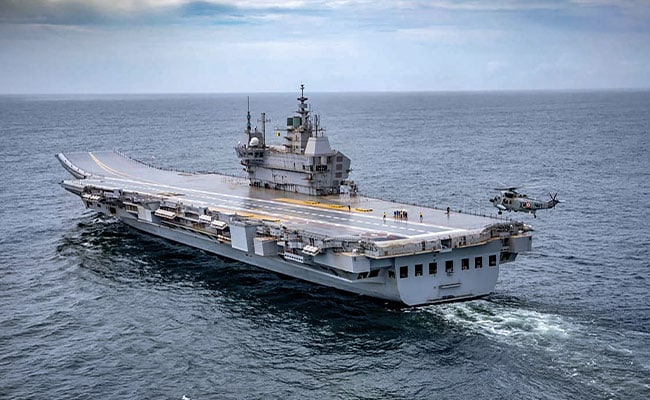
Fujian aircraft carrier will be the first conventional-energy-powered platform with the EMALS system.
China's third aircraft carrier, Fujian, took to the seas last week for its maiden trials, a significant moment in its naval expansion to challenge the US global presence. The new aircraft carrier is named after the Fujian province and is the largest, most advanced Chinese aircraft carrier ever built.
Fujian carrier departed from Shanghai's Jiangnan Shipyard, and the trials will primarily test the reliability and stability of the aircraft carrier's propulsion and electrical systems, state news agency Xinhua reported.
The trials will be conducted for almost two years before the carrier is inducted in another five years. The People's Liberation Army Navy (PLAN) is the "largest navy" in the world, surpassing the US with over 370 battleships, the US Department of Defense said.
'More Heavy, More Advanced'
The Fujian carrier is expected to weigh 79,000 tons, carrying the most potent fighter jet launch system - Electromagnetic Aircraft Launch System (EMALS). Currently, the USS Gerald R Ford, the world's largest aircraft carrier, uses the EMALS launch system. The other Chinese aircraft carriers, Liaoning and Shandong, use the ski-jump system.

CATOBAR and STOBAR are two types of aircraft carrier platforms. Short Take-Off Barrier-Assisted Recovery (STOBAR) comprises an elevated ski-ramp that helps a fighter jet generate lift during a take-off. The STOBAR platform limits the aircraft's take-off weight, thus affecting the payload capacity.
Meanwhile, the CATOBAR system uses catapults for take-off. The CATOBAR-based carriers have a steam-powered catapult system, which requires more maintenance, is heavy, and takes more space than its alternative. The EMALS catapult offers more smooth, accurate launching of an aircraft carrier, allowing heavier fighter jets to take off.
China operates only the Chengdu J-15, the 'Flying Shark', fighter jets for its carrier-based operations. J-15 is a fourth-generation fighter jet, which is deployed on its STOBAR carriers. However, the US has critiqued its range/payload limitations in operations from carriers equipped with ski ramps rather than catapults.
In 2021, China developed a catapult-based version of the fighter jet and is developing its fifth-generation fighters to match the US F-35. The US Department of Defence, in its latest report on Chinese naval modernization, said China is reportedly building a fourth aircraft carrier similar to Fujian and is expected to be nuclear-powered. The Fujian aircraft carrier will be the first conventional-energy-powered platform with the EMALS system.
China's Naval Expansion
Since the 1990s, China has witnessed a paradigm shift, with a focus on naval expansion rather than the PLA. The shift was driven by its economic growth through the 90s and early 2000s, which led to a rise in Chinese presence in the global economy and turned it into the manufacturing hub of the world. The PLAN slowly transitioned from a defensive-offensive arm to a force that is capable of conducting out-of-area operations and earned the tag of a Blue Water navy.
Modernisation, which began three decades ago, focused on ship, aircraft weaponry, fighter jets, creating doctrines, training, multilateral exercises etc. The 2015 Chinese white paper of Defence called for safeguarding the Sea Links of Communication (SLOC) as part of its national interests and said the sea links are vital to China's future. The Indian Ocean, the maritime backyard of India, is the toll-gate for global East-West trade and China is establishing maritime bases south of India to protect its Maritime Silk Road (MSR).
The Indian Ocean Region (IOR) is home to about 2.5 billion people, with some global economies, like India, a regional power, having a dominant presence in the region. The Strait of Hormuz, Bab-el-Mandeb, Strait of Malacca and the Mozambique Channel are choke points in the region and routes vital to China's global trade.
"The vital feature which differentiates the Indian Ocean from the Atlantic or the Pacific is the subcontinent of India, which juts out far into the sea for a thousand miles. It is the geographical position of India that changes the character of the Indian Ocean." KM Pannikar, a visionary Indian scholar said. The Navy, in its maritime doctrine, says that safeguarding the IOR is in India's national interest.
The US DoD suggests that although these carriers have value for China, its operations in Taiwan do not require such platforms since it is within the land-based reach of Chinese aircraft. These platforms assert dominance and are viewed as symbols of power. In a face-off between the US and China, the former will outperform and outmanoeuvre the PLAN with its prowess. Politically, aircraft carriers could be particularly valuable to China for projecting an image of China as a major world power.
China wants its navy to be able to deter "US intervention in a conflict in China's near-seas region over Taiwan or some other issue, or failing that, delay the arrival or reduce the effectiveness of intervening US forces," a Congressional Research Service report said.
India's Third Aircraft Carrier
Former Navy chief Admiral R Hari Kumar said last year that the indigenous aircraft carrier-2 (IAC-2) would be a repeat order of INS Vikrant. "We are still working on what size IAC II should be and the capabilities that are desired. But, for now, we have put a hold on it because we have just commissioned INS Vikrant and we are quite happy with the way the ship performed in the trials." "A lot of expertise has been gained in building IAC I. We are seriously looking at a repeat order for IAC I rather than building IAC II. This would capitalize on the expertise available in the country and we could plough back into the economy," he added.
INS Vikrant and INS Vikramaditya are built on the STOBAR platform and house the MiG-29K fighter jets. The naval version of Rafale and Tejas are expected to replace the MiGs soon.

The production of INS Vishal would begin soon, but it would still take many years for the new carrier to get commissioned. The size of the Chinese economy and its three times bigger defence budget than India's should be considered.
The QUAD alliance between the US, India, Australia and Japan for safeguarding the Indo-Pacific region and the Indian Navy's regular multilateral exercises in the region ensure regional presence and dominance.

 1 week ago
37
1 week ago
37











 English (US) ·
English (US) ·  Turkish (TR) ·
Turkish (TR) ·